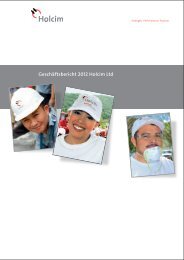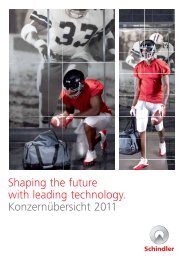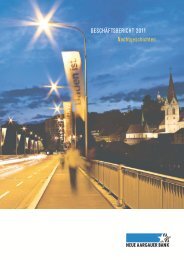Transocean Proxy Statement and 2010 Annual Report
Transocean Proxy Statement and 2010 Annual Report
Transocean Proxy Statement and 2010 Annual Report
Create successful ePaper yourself
Turn your PDF publications into a flip-book with our unique Google optimized e-Paper software.
impartiality of the local courts; <strong>and</strong> the potential for changes in the taxes paid to one country that either produce, or fail to produce,<br />
offsetting tax changes in other countries.<br />
We consider the earnings of certain of our subsidiaries to be indefinitely reinvested. As such, we have not provided for taxes on<br />
these unremitted earnings. At December 31, <strong>2010</strong>, the amount of indefinitely reinvested earnings was approximately $2.0 billion. Should<br />
we make a distribution from the unremitted earnings of these subsidiaries, we would be subject to taxes payable to various jurisdictions.<br />
We estimate taxes in the range of $150 million to $200 million would be payable upon distribution of all previously unremitted earnings at<br />
December 31, <strong>2010</strong>.<br />
We have recognized deferred taxes related to the earnings of certain subsidiaries that are not permanently reinvested or that will<br />
not be permanently reinvested in the future. If facts <strong>and</strong> circumstances cause us to change our expectations regarding future tax<br />
consequences, the resulting adjustments to our deferred tax balances could have a material effect on our consolidated statement of<br />
financial position, results of operations or cash flows.<br />
Estimates, judgments <strong>and</strong> assumptions are required in determining whether deferred tax assets will be fully or partially realized.<br />
When it is estimated to be more likely than not that all or some portion of certain deferred tax assets, such as foreign tax credit carryovers<br />
or net operating loss carryforwards, will not be realized, we establish a valuation allowance for the amount of the deferred tax assets that is<br />
considered to be unrealizable. We continually evaluate strategies that could allow for the future utilization of our deferred tax assets. We<br />
did not make any significant changes to our valuation allowance against deferred tax assets during the years ended December 31, 2008,<br />
2009 <strong>and</strong> <strong>2010</strong>.<br />
See Notes to Consolidated Financial <strong>Statement</strong>s—Note 6—Income Taxes.<br />
Goodwill—The carrying amount of goodwill was $8.1 billion, representing 22 percent of our total assets, as of December 31,<br />
<strong>2010</strong>. We conduct impairment testing for our goodwill annually as of October 1 <strong>and</strong> more frequently, on an interim basis, when an event<br />
occurs or circumstances change that may indicate a reduction in the fair value of a reporting unit below its carrying amount. We test<br />
goodwill at the reporting unit level, which is defined as an operating segment or a component of an operating segment that constitutes a<br />
business for which financial information is available <strong>and</strong> is regularly reviewed by management. We have determined that our reporting<br />
units for this purpose are as follows: (1) contract drilling services, (2) drilling management services <strong>and</strong> (3) oil <strong>and</strong> gas properties.<br />
To determine the fair value of each reporting unit, we use a combination of valuation methodologies, including both income <strong>and</strong><br />
market approaches. For our contract drilling services reporting unit, we estimate fair value using discounted cash flows, publicly traded<br />
company multiples <strong>and</strong> acquisition multiples. To develop the projected cash flows associated with our contract drilling services reporting<br />
unit, which are based on estimated future dayrates <strong>and</strong> utilization, we consider key factors that include assumptions regarding future<br />
commodity prices, credit market conditions <strong>and</strong> the effect these factors may have on our contract drilling operations <strong>and</strong> the capital<br />
expenditure budgets of our customers. We discount projected cash flows using a long-term weighted-average cost of capital, which is<br />
based on our estimate of the investment returns that market participants would require for each of our reporting units. To develop the<br />
publicly traded company multiples, we gather available market data for companies with operations similar to our reporting units <strong>and</strong><br />
publicly available information for recent acquisitions in the marketplace.<br />
Because our business is cyclical in nature, the results of our impairment testing are expected to vary significantly depending on<br />
the timing of the assessment relative to the business cycle. Altering either the timing of or the assumptions used in a reporting unit’s fair<br />
value calculations could result in an estimate that is significantly below its carrying amount, which may indicate its goodwill is impaired.<br />
For our annual impairment testing, conducted on October 1, <strong>2010</strong>, the remaining goodwill was associated with our contract<br />
drilling services reporting unit. In calculating the fair value of this reporting unit for the annual impairment test, we applied a discount rate<br />
of 11 percent <strong>and</strong> a terminal growth rate of three percent to our contract drilling services reporting unit. Applying a hypothetical<br />
three percent increase in the discount rate <strong>and</strong> a hypothetical 10 percent decrease in our projected cash flows for the annual impairment<br />
test would not have resulted in the impairment of goodwill associated with the contract drilling services reporting unit.<br />
Property <strong>and</strong> equipment—The carrying amount of our property <strong>and</strong> equipment was $21 billion as of December 31, <strong>2010</strong>,<br />
representing 58 percent of our total assets. The carrying amount of these assets is subject to our estimates, assumptions, <strong>and</strong> judgments<br />
related to capitalized costs, useful lives <strong>and</strong> salvage values.<br />
Capitalized costs—We capitalize costs incurred to enhance, improve <strong>and</strong> extend the useful lives of our assets <strong>and</strong> expense<br />
costs incurred to repair <strong>and</strong> maintain the existing condition of our rigs. Capitalized costs increase the carrying amounts <strong>and</strong> depreciation<br />
expense of the related assets, which would also impact our results of operations.<br />
Useful lives—We depreciate our assets over their estimated useful lives, which we determine by applying judgments <strong>and</strong><br />
assumptions that reflect both historical experience <strong>and</strong> expectations regarding future operations, utilization <strong>and</strong> asset performance. Useful<br />
lives of rigs are difficult to estimate due to a variety of factors, including (a) technological advances that impact the methods or cost of oil<br />
<strong>and</strong> gas exploration <strong>and</strong> development, (b) changes in market or economic conditions, <strong>and</strong> (c) changes in laws or regulations affecting the<br />
drilling industry. Applying different judgments <strong>and</strong> assumptions in establishing the useful lives would likely result in materially different net<br />
carrying amounts <strong>and</strong> depreciation expense for our assets. We evaluate the remaining useful lives of our rigs when certain events occur<br />
that directly impact the useful lives of the rigs, including changes in operating condition, functional capability <strong>and</strong> market <strong>and</strong> economic<br />
factors. When evaluating the remaining useful lives of rigs, we also consider major capital upgrades required to perform certain contracts<br />
AR-64

















